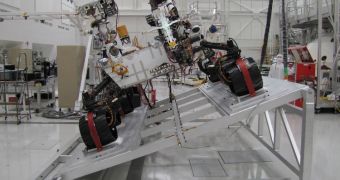Experts at NASA announce that an effort to produce alternative cameras for the Mars Science Laboratory (MSL) rover Curiosity has been halted, due to time constraints. The existing cameras were also determined to be more than capable of fulfilling the science goals the robot has set up.
The Mast Camera (Mastcam) instrument is already installed on the vehicle, and engineers have been planning to launch the rover with it all along. However, NASA officials also asked the company that designed Mastcam to research a potential alternative.
At this point, the installed instrument is powered by two fixed-focal-length cameras, of which the first one provides a telephoto, while the second one provides wide-angle capabilities.
In 2010, San Diego-based company Malin Space Science Systems (MSSS), the developers of the Mastcam, were asked and funded by NASA to create an alternative to the instrument. The new device was to feature zoom-lens cameras, that would have provided additional capabilities for 3D video.
The American space agency said at the time that the funds it gave to MSSS were destined to verify whether the alternative instrument could be developed in due time. Work on it has now been stopped.
“With the Mastcam that was installed last year and the rover's other instruments, Curiosity can accomplish its ambitious research goals,” explains MSL project scientist John Grotzinger.
“Malin Space Science Systems has provided excellent, unprecedented science cameras for this mission,” adds the expert, who is based at the California Institute of Technology (Caltech), in Pasadena.
“The possibility for a zoom-camera upgrade was very much worth pursuing, but time became too short for the levels of testing that would be needed for them to confidently replace the existing cameras,” he goes on to say.
“We applaud Malin Space Science Systems for their tremendous effort to deliver the zooms, and also the Mars Science Laboratory Project's investment in supporting this effort,” Grotzinger explains.
In addition to the Mastcam, MSSS also provided Curiosity with the Mars Hand Lens Imager and the Mars Descent Imager instruments. All of them will fly to the Red Planet later this year, and are scheduled to land there in 2012.
“Although we are very disappointed that the zoom cameras will not fly, we expect the fixed-focal-length cameras to achieve all of the primary science objectives of the Mastcam investigation,” explains the principal investigator of the Mastcam, Michael Malin.
Right now, the MSL platform is undergoing rigorous tests inside a Martian simulator chamber at the NASA Jet Propulsion Laboratory (JPL), in Pasadena, California. The JPL is managed by Caltech.
Curiosity will be the largest and most complex rover ever deployed on another celestial body. It main features include a nuclear engine, lasers for zapping rocks from far away and internal ovens for astrobiology research.

 14 DAY TRIAL //
14 DAY TRIAL //